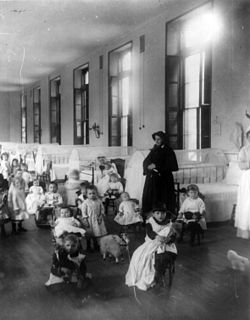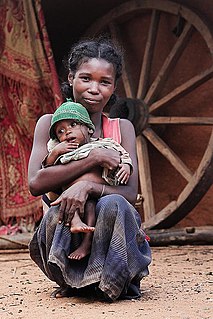
Adoption is a process whereby a person assumes the parenting of another, usually a child, from that person's biological or legal parent or parents. Legal adoptions permanently transfer all rights and responsibilities, along with filiation, from the biological parents to the adoptive parents.

A mother is the female parent of a child. Mothers are women who inhabit or perform the role of bearing some relation to their children, who may or may not be their biological offspring. Thus, dependent on the context, women can be considered mothers by virtue of having given birth, by raising their child(ren), supplying their ovum for fertilisation, or some combination thereof. Such conditions provide a way of delineating the concept of motherhood, or the state of being a mother. Women who meet the third and first categories usually fall under the terms 'birth mother' or 'biological mother', regardless of whether the individual in question goes on to parent their child. Accordingly, a woman who meets only the second condition may be considered an adoptive mother, and those who meet only the first or only the third a surrogacy mother.

A parent is a caregiver of the offspring in their own species. In humans, a parent is the caretaker of a child. A biological parent is a person whose gamete resulted in a child, a male through the sperm, and a female through the ovum. Biological parents are first-degree relatives and have 50% genetic meet. A female can also become a parent through surrogacy. Some parents may be adoptive parents, who nurture and raise an offspring, but are not biologically related to the child. Orphans without adoptive parents can be raised by their grandparents or other family members.
Griswold v. Connecticut, 381 U.S. 479 (1965), was a landmark decision of the US Supreme Court in which the Court ruled that the Constitution of the United States protects the liberty of married couples to buy and use contraceptives without government restriction. The case involved a Connecticut "Comstock law" that prohibited any person from using "any drug, medicinal article or instrument for the purpose of preventing conception". The court held that the statute was unconstitutional, and that "the clear effect of [the Connecticut law ...] is to deny disadvantaged citizens ... access to medical assistance and up-to-date information in respect to proper methods of birth control." By a vote of 7–2, the Supreme Court invalidated the law on the grounds that it violated the "right to marital privacy", establishing the basis for the right to privacy with respect to intimate practices. This and other cases view the right to privacy as a right to "protect[ion] from governmental intrusion".
The international adoption of South Korean children was at first started as a result of a large number of orphaned mixed children from the Korean War after 1953, but later included orphaned Korean children. Religious organizations in the United States, Australia, and many Western European nations slowly developed into the apparatus that sustained international adoption as a socially integrated system. This system, however, is essentially gone as of 2020. The number of children given for adoption is lower than in comparable OECD countries of a similar size, the majority of adoptees are adopted by South Korean families, and the number of international adoptees is at a historical low.
Closed adoption is a process by which an infant is adopted by another family, and the record of the biological parent(s) is kept sealed. Often, the biological father is not recorded—even on the original birth certificate. An adoption of an older child who already knows his or her biological parent(s) cannot be made closed or secret. This used to be the most traditional and popular type of adoption, peaking in the decades of the post-World War II Baby Scoop Era. It still exists today, but it exists alongside the practice of open adoption. The sealed records effectively prevent the adoptee and the biological parents from finding, or even knowing anything about each other. However, the emergence of non-profit organizations and private companies to assist individuals with their sealed records has been effective in helping people who want to connect with biological relatives to do so.

More adoptions occur in California each year than any other state. There is domestic adoption, international adoption, step parent adoption and adult adoption.
In the United States, adoption is the process of creating a legal parent-child relationship between a child and a parent who was not automatically recognized as the child's parent at birth.
Open adoption is a form of adoption in which the biological and adoptive families have access to varying degrees of each other's personal information and have an option of contact. While open adoption is a relatively new phenomenon in the west, it has been a traditional practice in many Asian societies, especially in South Asia, for many centuries. In Hindu society, for example, it is relatively common for a childless couple to adopt the second or later son of the husband's brother when the childless couple has limited hope of producing their own child.
The Adoption Information Disclosure Act, formally An Act respecting the disclosure of information and records to adopted persons and birth parents, also known as Bill 183, is an Ontario (Canada) law regarding the disclosure of information between parties involved in adoptions.
Pregnancy options counseling is a form of counseling that provides information and support regarding pregnancy. Women seeking pregnancy options counseling are typically doing so in the case of an unplanned or unintended pregnancy. Limited access to birth control and family planning resources, as well as misuse of birth control are some of the major contributing factors to unintended pregnancies around the world. In 2012, the global rate of unintended pregnancies was estimated to be 40 percent, or eighty-five million pregnancies.
The topic of Islam and children includes the rights of children in Islam, the duties of children towards their parents, and the rights of parents over their children, both biological and foster children. Also discussed are some of the differences regarding rights with respect to different schools of thought.
Mother's rights are the legal obligations for expecting mothers, existing mothers, and adoptive mothers in the United States. Issues that involve mothers' rights include labor rights, breast feeding, and family rights.
The Infanticide Act, often referred to as "Infanticide act of Gustav III" after its instigator Gustav III of Sweden, was a historical Swedish law, which was introduced in 1778 and in effect until 1917, with alterations in 1856.
Catherine Gertrude Roraback was a civil rights attorney in Connecticut, best known for representing Estelle Griswold and Dr. C. Lee Buxton in the famous 1965 Supreme Court case, Griswold v. Connecticut, which legalized the use of birth control in Connecticut and created the precedent of the right to privacy. She is also known for such cases as the New Haven Black Panther trials of 1971, in which she defended Black Panther member Ericka Huggins after she was accused of murder. Roraback dealt with issues such as women's rights and racial discrimination, and lived her life to defend the rights of the "dissenters and the dispossessed".
The following outline is provided as an overview of and topical guide to adoption:

Estelle Naomi Trebert Griswold was a civil rights activist and feminist most commonly known as a defendant in what became the Supreme Court case Griswold v. Connecticut, in which contraception for married couples was legalized in the state of Connecticut, setting the precedent of the right to privacy. Griswold served as the Executive Director of Planned Parenthood in New Haven when she and Yale professor C. Lee Buxton opened a birth control clinic in New Haven in an attempt to change the Connecticut law banning contraception. Their actions set into motion legislation that resulted in both Poe v. Ullman and Griswold v. Connecticut.
Pregnancy options counseling is a form of counseling to help a woman come to a decision regarding a troubling or unintended pregnancy. In the United States, approximately 51% of the six million annual pregnancies are unintended. A majority of the women affected by an unintended pregnancy are aged 20–24, poor or low income, or a member of a minority group. Unintended pregnancy rates are generally higher in the South and Southwest regions of the United States and densely populated areas. A lack of family planning, limited access to birth control, and inconsistent use of birth control are three of the contributing factors to unintended pregnancy.

An anonymous birth is a birth where the mother gives birth to a child without disclosing her identity, or where her identity remains unregistered. In many countries, anonymous births have been legalized for centuries in order to prevent formerly frequent killings of newborn children, particularly outside of marriage.
Adoption does not exist formally as a practice in Jewish Law (Halacha), although rabbinic texts were not uniform on whether or not they recognized the validity of adoption and several examples of adoption take place in the Hebrew Bible and texts from Second Temple Judaism. The Hebrew word for adoption ‘אימוץ’ (immutz), which derives from the verb ‘אמץ’ (amatz) in Psalm 80 verse 16 and 18 meaning ‘to make strong’, was not introduced until the modern age. Jewish perspectives towards adoption promote two contradictory messages towards nurture and nature. On the one hand, Judaism expresses favourable attitudes towards adoption across religious movements and is widely viewed as a good deed (mitzvah). Based on the Talmudic teachings that when one raises an orphan in their home, "scripture ascribes it to him as though he had begotten him," Rabbis have argued that the commandment of procreation can also be fulfilled through the act of adoption. However, this interpretation raises a number of questions in relation to lineage and biological status, which is a core value in Halacha.





